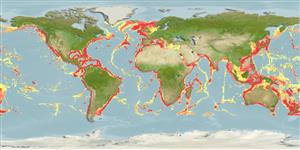Classification / Names
Common names from other countries
Main reference
Size / Weight / Age
Max length : 482 cm TL male/unsexed; (Ref. 247); common length : 300 cm TL male/unsexed; (Ref. 5217); max. published weight: 590.0 kg (Ref. 27436)
Length at first maturity
Lm ?, range 400 - 482 cm
Environment
Marine; bathydemersal; oceanodromous (Ref. 51243); depth range 1 - 2500 m (Ref. 58302), usually 180 - 1100 m (Ref. 45445)
Climate / Range
Subtropical, preferred 25°C (Ref. 107945); 65°N - 48°S, 180°W - 180°E
Distribution
Circumglobal: In tropical and temperate waters; (Ref. 13573). Western Atlantic: North Carolina to Florida (USA) and northern Gulf of Mexico to northern Argentina. Eastern Atlantic: Iceland and Norway to Namibia, including the Mediterranean. Indian Ocean: Madagascar, Mozambique, South Africa, and Arabian Sea (Ref.85183). Western Pacific: eastern Japan to New Zealand and Hawaii. Eastern Pacific: Aleutian Islands, Alaska to Baja California, Mexico; also Chile . Highly migratory species, Annex I of the 1982 Convention on the Law of the Sea (Ref. 26139, Ref. 41819).
Countries | FAO areas | Ecosystems | Occurrences | Introductions
Short description
Dorsal
spines
(total): 0;
Dorsal
soft rays
(total): 0;
Anal
spines: 0;
Anal
soft rays: 0. A heavily-bodied, broad-headed sixgill shark, mouth ventral with 6 rows of lower, bladelike, comb-shaped teeth on each side (Ref. 247). Snout broadly rounded, body fusiform (Ref. 6871). Anal fin smaller than dorsal fin (Ref. 6871). Brown or grey above, paler below, with a light stripe along side (Ref. 26346). Fins with white edges (Ref. 6574). Live specimens with fluorescent green eyes (Ref. 6871). Six gill slits are very long (Ref. 35388).
IUCN Red List Status (Ref. 115185)
Threat to humans
Poisonous to eat (Ref. 4690)
Human uses
Fisheries: commercial; gamefish: yes
Tools
Special reports
Download XML
Internet sources
Estimates of some properties based on models
Phylogenetic diversity index
PD50 = 0.8281 many relatives (e.g. carps) 0.5 - 2.0 few relatives (e.g. lungfishes)
Trophic Level
4.5 ±0.2 se; Based on diet studies.
Resilience
Low, minimum population doubling time 4.5 - 14 years (Fec= 22-108)
Vulnerability
Very high vulnerability (84 of 100)
Price category
